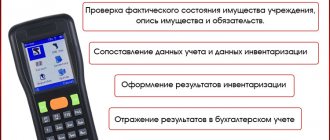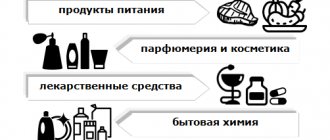The act of writing off goods in the TORG-16 form is useful in cases where goods in the organization’s warehouse have become unusable and need to be written off. This document confirms the legality of the actions of the storekeeper or other financially responsible person.
- Form and sample
- Online viewing
- Free download
- Safely
FILES
The document will be especially useful for food organizations, pharmacies and other companies that deal with perishable goods.
Important point! Write-offs cannot be made without the knowledge of the head of the organization. An order or instruction must be drawn up on his behalf.
If the amounts for which goods are written off are insignificant, and the process of deregistering goods is carried out regularly, then the manager can issue an order of the appropriate content, implying regular write-offs. But still, a reference to the order will be required for the act of writing off goods in the TORG-16 form.
It is worth noting that the procedure for writing off inventory items (inventory) is carried out only in the presence of a commission, the members of which are responsible and sign on the paper that the write-off was carried out according to all the rules. They also check whether the numbers in the document correspond to the actual quantity of goods being written off.
Elements of the act
The paper must be on at least two sheets. Each sheet contains a table. In the presented samples, the first table contains 13 rows, the second – 12. If necessary, the number of rows can be increased. Then the entire document will occupy more sheets. However, even in this case, it will be considered a unified form and is unlikely to provoke questions during inspections.
For your information! Since 2013, legislation has significantly relaxed the requirements for document flow in organizations. The TORG-16 form is no longer the only correct one for writing off unusable goods. You can document the fact of write-off on any form. The main thing is that it contains all the necessary details and the form is accepted by order of the manager and is present in the company’s accounting policies.
Most managers, storekeepers and accounting workers tend to use this particular form of document, since the data will be placed in it conveniently and compactly. In addition, it does not raise any questions when conducting re-registration by controlling organizations.
When needed
The organization approves in the Accounting Policies
primary documents that are used to formalize operations for the
transfer of materials
into operation. These may be (parts 1, 2, 4 of Article 9 of the Federal Law of December 6, 2011 N 402-FZ, clauses 98, 100, 109 of the Methodological Instructions on the Management of MPZ, approved by Order of the Ministry of Finance of the Russian Federation of December 28, 2001 N 119n, Resolution of GOSKOMSTAT dated October 30, 1997 N 71a):
- unified forms (M-8, M-11, M-15, M-17...);
- independently developed forms (Write-off act...).
Main – Settings – Accounting policies – Print button – Forms of primary documents:
More details:
- Accounting policy in 1C 8.3 Accounting 3.0
- Composition of Accounting Policies
- When can changes be made to the Accounting Policies?
- Example of changes/additions to Accounting Policies
- Accounting policy for accounting for advance payments for income tax
- Setting up Accounting Policy for NU in 1C: USN
- Example of an Accounting Policy for Production (OSNO)
- Example of Accounting Policy for Trade (STS)
Material write-off act
is used to confirm the write-off of materials and reflect costs (clause 98 of the Methodological Instructions on BU MPZ, approved by Order of the Ministry of Finance of the Russian Federation dated December 28, 2001 N 119n, paragraphs 1, 2 of Article 272 of the Tax Code of the Russian Federation):
- when transferring inventory items (inventory items), for which at the time of their issuance the purposes
for which the inventory items will be spent are known or - if the materials were previously issued under the document Request-invoice ( M-11
) and the specific purpose of use at the time of transfer was unknown and not indicated
Warehouse (Production) – Request invoice – Print:
First page of the act
The act of write-off of goods in the TORG-16 form begins with a reference to Goskomstat Resolution No. 132 of December 25, 1998 in the right-left corner of the page. It was this resolution that established this form as a unified form for writing off goods. It has been used for a long time, and it still remains relevant.
After the link to the legislative framework there is a miniature table with codes. The OKPO code is already indicated, it remains unchanged when using this form - 0330216. It is already printed. In addition, it must contain the code according to OKPO, the type of activity according to OKDP and the coding of the type of operation. To the left of the code table there is space to indicate the full name of the organization and if there is a structural unit. The latter can be a warehouse, workshop, storeroom, etc.
An important point is the basis for drawing up the act. One column is allocated for it at the top of the document. In addition to the name of the document, it must contain its number and date of signing.
Since during the write-off of goods the risk of fraud on the part of employees increases, on each write-off act there is a separate space for the approval of the manager. The completed act must bear the signature of the manager with a transcript, position and date of issue. The act is assigned a number. It and the date of signing are placed immediately after the title of the document.
Form of the act
There is no uniform form for these purposes established by law. Although you still need to know about some rules. The Goskomstat decree states that the recommended templates for writing off products are forms TORG-15 and TORG-16. Until 2013, these forms were considered mandatory for writing off goods and registering their damage. However, this does not at all prohibit organizations from developing and approving their own form. Practice shows that in almost all situations existing forms are used. They are considered quite convenient and understandable. In addition, you can enter additional information here if necessary.
Where is it used?
As a rule, this act is used in enterprises that are engaged in the production and transportation of products, their sale and storage. Accordingly, this category includes various stores, warehouses, shopping centers, and food processing enterprises. If products are not sold within the expiration date, they are subject to write-off. This procedure is accompanied by the execution of a special act.
As you might guess, the sale of such a product will cause serious problems with the law. The smallest punishment that an organization faces involves a fairly large fine. This is why unconsumable products are written off. In essence, they are returned to managers and other representatives of suppliers and manufacturers. They are the ones who determine the future fate of the products. Such actions have many advantages:
- positive impact on the environment;
- the ability to send illiquid assets for processing;
- reduction of waste in landfills, since discarded goods are not thrown into trash bins;
- reducing the risk of spreading dangerous infections.
( Video : "Disposal of expired food")
First table
After the header in the attached form there is a fairly simple table. It contains columns that should contain information about:
- Dates of receipt and write-off of the goods described in each line. Indicated for each name separately. It is unacceptable to place different products on the same line.
- The number and date of the delivery note. It is the connecting link of the act and is needed for the correct formation of financial statements.
- Reasons. They represent signs of deterioration in quality, which led to the impossibility of using the inventory items listed in the table for their intended purpose. There is also a column for indicating the code if the company has adopted the encoding. But usually these fields are left empty.
The reasons for write-off are varied:
- Damage. Intentional or unintentional. The appointment of a financially responsible person is precisely necessary for such cases.
- Marriage. Factory or identified later during inventory.
- Violation of the integrity of the packaging.
- Expiration of the implementation period. This is the most common reason for write-offs.
When closing an organization, unsold goods are also subject to write-off.
Filling out the form for the act of writing off goods in the TORG-16 form can only be done in printed form. On the reverse side of the sheet there must be signatures by a commission convened specifically for such a case, and in most cases not all employees of the institution have electronic signatures. Usually they resort to mixed filling: the columns of the tables are formed electronically, the act is printed, and then all financially responsible persons leave their signatures, and the organization’s seal is affixed (if any).
Write-off of products spoiled due to force majeure
Force majeure can also cause food spoilage. For example, recently many kindergartens were faced with the need to write off food in preschool educational institutions due to coronavirus. If an unforeseen event occurs, then the decision to write off must be made by the commission and, in addition, supported by certificates issued by the relevant authorities (in the case of the introduction of quarantine - Rospotrebnadzor).
Products that have become unusable are written off as extraordinary expenses. The basis for starting the write-off procedure is an internal order from the manager. The order form is not unified and is developed individually by the preschool institution. An example of an order is given below.
The fact of write-off of food products in the preschool educational institution due to force majeure is confirmed by the act of write-off of inventories.
Second page
On the second page there is a table that should provide data on:
- Code and full name of the product.
- OKEI code and the name of the unit of measurement by which the written-off inventory value is measured. This can be a unit, kg, gram, etc.
- Quantity. This column usually contains only one number. If the previous column does not indicate units of measurement, then it is assumed that the number of occupied spaces in the warehouse is indicated here.
- Masse. The total weight of all goods written off in a specific line and one piece (if possible) is indicated.
- Price and value.
- Other data that is fundamentally important when writing off. This column is called “Note”.
After the second table, the total write-off amount is indicated separately in words. Directly below it are signed by the chairman and all members of the commission who were present during the write-off and guarantee that the procedure was carried out correctly. After them, the financially responsible person signs. All “autographs” must have a transcript. The positions of the persons who placed them are written next to them.
The act of writing off goods in the TORG-16 form is completed by the decision of the manager as to what this write-off should be attributed to. This may be a write-off as expenses or the appointment of a financially responsible person responsible for the shortage. If the latter, then the employee will be required to compensate for the damage caused.
What rules to consider when filling out the form?
There are three simple rules for filling out TORG-16:
- The act is drawn up in three original copies (1 - for accounting, 2 - for the financially responsible person, 3 - remains in the department).
- Write-offs are made on commission. TORG-16 is signed by all members of the commission authorized to take such actions by the head of the organization.
- Representatives of sanitary or other supervision may participate in drawing up the act.
Find out about consumer rights protection opportunities from our publications:
- “You can now write a complaint about the store to the MFC”;
- “How to correctly write a claim for the return of shoes.”
Compiling a document
There is no unified form for such an act. A company can develop its own form and secure it with a special order in its accounting policies. You can fill out the form by hand or on a computer. A prerequisite is that the signatures on the act be “live”, that is, the document typed on a computer must be printed and signed.
In order for a food disposal act to have legal significance, it must contain the standard details and information for such a document:
- Name of company.
- The name of the document and its number.
- Date and place of drawing up the act.
- Information about the composition of the commission. List the positions and names of the commission members.
- Information about the disposal procedure carried out. Here indicate the date of its holding and place, if desired.
- Information about food products: name, reason for disposal, quantity or weight of the product, price, total cost for each item and for all together. This item is usually presented in the form of a table.
- An indication that the product has been spoiled or has expired, etc. The commission confirms this fact, as well as the fact that the product was disposed of properly. In addition, you can indicate the method in which the goods were destroyed.
- Signatures of commission members with transcripts.
Attention!
Some categories of products after the expiration date may pose a threat to human health and life. In this case, it is necessary that the disposal procedure be agreed upon with Rospotrebnadzor. In addition, one copy of the act or a copy of it certified in accordance with all the rules of law will need to be sent to the department. This is necessary to confirm that potentially dangerous products have been destroyed.










